The Characters.
Calvin - I've found out that Calvin is named for a
sixteenth-century theologian who believed in predestination. Most people
assume that Calvin is based on a son of Bill Watterson, or based on detailed
memories of his own childhood. In fact, he don't have children, and he was a
fairly quiet, obedient kid--almost Calvin's opposite. One of the reasons
that Calvin's character was fun to write is that Bill often doesn't agree
with him.
 Calvin is
autobiographical in the sense that he thinks about the same issues that Bill
do, but in this, Calvin reflects his adulthood more than his childhood. Many
of Calvin's struggles are metaphors for Bills own. I suspect that most of us
get old without growing up, and that inside every adult (sometimes not very
far inside) is a bratty kid who wants everything his own way. Bill use
Calvin as an outlet for his immaturity, as a way to keep himself curious
about the natural world, as a way to ridicule his own obsessions, and as a
way to comment on human nature. I wouldn't want Calvin in my house, but on
paper, he helps me sort through my life and understand it.
Calvin is
autobiographical in the sense that he thinks about the same issues that Bill
do, but in this, Calvin reflects his adulthood more than his childhood. Many
of Calvin's struggles are metaphors for Bills own. I suspect that most of us
get old without growing up, and that inside every adult (sometimes not very
far inside) is a bratty kid who wants everything his own way. Bill use
Calvin as an outlet for his immaturity, as a way to keep himself curious
about the natural world, as a way to ridicule his own obsessions, and as a
way to comment on human nature. I wouldn't want Calvin in my house, but on
paper, he helps me sort through my life and understand it.
I'm obviously a big fan of Calvin, his likeness graces this site just as much as Hobbes. I grew up reading Calvin and Hobbes. When
I was young, Calvin was everything I wanted to be. With his sophisticated
vocabulary, devious plans, and firm grasp on the business world, he always
seemed smarter than his peers and adults.
Ironically, when I rediscovered Calvin and Hobbes a few years back, I
found myself appreciating not his adult like characteristics, but his
childishness. Calvin is, most of the time, the personification of
rambunctious youth. Though he sometimes breaks character, for the most part
he is as accurate a depiction of a 6 year old I've ever seen. Many of his
"adult-like" acts, such as polling his dad, are so crazy that it seems they
could only sprout from the mind of a little kid.
When Calvin and Hobbes ended, I didn't read many articles praising Watterson
for crafting such a realistic 6 year old. At the time I did not understand
the message they were trying to convey. Sure, Calvin seemed like a
realistic 6 year old to me, but I did not realize what a momentous task
creating (and sub staining) such a reasonable character was. Only now,
after I have seen countless comic strips fail in their attempt to portray a
realistic child, can I truly appreciate Watterson and his work. The best
example of all this I can think of is the many Christmas Strips published
over the years. I bet everyone can remember feeling just the way Calvin
did in the weeks leading up to Christmas. Watterson has captured every
child's "fear of Santa Clause" perfectly.
 Hobbes
- Hobbes is named after a seventeenth-century philosopher with a dim view of
human nature, Hobbes has the patient dignity and common sense of most
animals I've met. Hobbes was very much inspired by one of Bills cats, a gray
tabby named Sprite. Sprite not only provided the long body and facial
characteristics for Hobbes, she also was the model for his personality. She
was good-natured, intelligent, friendly, and enthusiastic in a
sneaking-up-and-pouncing sort of way. Sprite suggested the idea of Hobbes
greeting Calvin at the door in midair at high velocity.
Hobbes
- Hobbes is named after a seventeenth-century philosopher with a dim view of
human nature, Hobbes has the patient dignity and common sense of most
animals I've met. Hobbes was very much inspired by one of Bills cats, a gray
tabby named Sprite. Sprite not only provided the long body and facial
characteristics for Hobbes, she also was the model for his personality. She
was good-natured, intelligent, friendly, and enthusiastic in a
sneaking-up-and-pouncing sort of way. Sprite suggested the idea of Hobbes
greeting Calvin at the door in midair at high velocity.
With most cartoon animals, the humor comes from their humanlike behavior.
Hobbes stands upright and talks of course, but Bill try's to preserve his feline
side, both in his physical demeanor and his attitude. His reserve and tact
seem very catlike to me, along with his barely contained pride in not being
human. Like Calvin, I often prefer the company of animals to people, and
Hobbes is my idea of an ideal friend.
 The so-called
"gimmick" of Bill's strip--the two versions of Hobbes--is sometimes
misunderstood. I don't think of Hobbes as a doll that miraculously comes to
life when Calvin's around. Neither do I think of Hobbes as the product of
Calvin's imagination. The nature of Hobbes reality doesn't interest me, and
each story goes out of its way to avoid resolving the issue. Calvin sees
Hobbes one way, and everyone else sees Hobbes another way. I show two
versions of reality, and each makes complete sense to the participant who
sees it. I think that's how life works. None of us sees the world in exactly
the same way, and I just draw that literally in the strip. Hobbes is more
about the subjective nature of reality that about dolls coming to life.
The so-called
"gimmick" of Bill's strip--the two versions of Hobbes--is sometimes
misunderstood. I don't think of Hobbes as a doll that miraculously comes to
life when Calvin's around. Neither do I think of Hobbes as the product of
Calvin's imagination. The nature of Hobbes reality doesn't interest me, and
each story goes out of its way to avoid resolving the issue. Calvin sees
Hobbes one way, and everyone else sees Hobbes another way. I show two
versions of reality, and each makes complete sense to the participant who
sees it. I think that's how life works. None of us sees the world in exactly
the same way, and I just draw that literally in the strip. Hobbes is more
about the subjective nature of reality that about dolls coming to life.
Watterson says that Hobbes is his idea of an ideal friend. Well,
Hobbes does some things I would exactly consider friendly although his persistent
doorway attacks come to mind but he does seem to be generally a good
fellow. One thing that always bugged me about Hobbes was that though he was
a figment of Calvin's imagination, he constantly attacks and makes fun of
him. Why would Calvin allow something of his own creation do those kind of
things to him? Maybe Hobbes is Calvin's better half, keeping him in check,
so to speak... Well, at that point I (correctly) decided I was over
thinking this comic. Is Hobbes real? Is he fake? Who cares, it's just a
comic strip, and I can't think of one situation where the issue of Hobbes'
reality affected a story. If it doesn't matter in the strip, than why
should I bother thinking about it? But I digress...
To me, Calvin has always been the more interesting character of the
two. The main reason for this is that while Calvin's life consists of
several events away from Hobbes, Hobbes' life consists only of Calvin.
Calvin brings Hobbes to life, and so it seems only right to me that Calvin
be the more interesting of the two.
Of all the possible Calvin and Hobbes merchandise though, a stuffed
Hobbes doll tops my list. Not the "living" Hobbes, but Hobbes in his
stuffed state. That is one funny doll!
 Parents - Bill
has
never given Calvin's parents names, because as far as the strip is
concerned, they are important only as Calvin's mom and dad. Calvin's dad has
been rumored to be Bill's self-portrait. All my characters are half him, so
it's true in some ways, but Calvin's dad is also partly a satire of Bill's
father. Any strip about how suffering "builds character" is usually a
verbatim transcript of Bill dad's explanations for why we were all freezing,
exhausted, hungry, and lost on camping trips. These things are a lot funnier
after twenty-five years have passed.
Parents - Bill
has
never given Calvin's parents names, because as far as the strip is
concerned, they are important only as Calvin's mom and dad. Calvin's dad has
been rumored to be Bill's self-portrait. All my characters are half him, so
it's true in some ways, but Calvin's dad is also partly a satire of Bill's
father. Any strip about how suffering "builds character" is usually a
verbatim transcript of Bill dad's explanations for why we were all freezing,
exhausted, hungry, and lost on camping trips. These things are a lot funnier
after twenty-five years have passed.
Calvin's mom is the daily disciplinarian, a job that taxes her sanity, so
I don't think we get to see her at her best. I regret that the strip mostly
shows her impatient side, but Bill try's to hint at other aspect of her interests
by what she's doing when Calvin barges in.
 Early on, Calvin's
parents were criticized by readers for being unloving and needlessly
sarcastic. (Calvin's dad has remarked that what he really wanted was a dog.)
At the time, I think it was unusual for a comic strip to concentrate on the
exasperating aspects of kids without a lot of hugs and sentimentality to
leaven it. We usually only see Calvin's parents when they're reacting to
Calvin, so as secondary characters, Bill tried to keep them realistic, with
a reasonable sense of humor about having a kid like Calvin. I think they do
a better job than Bill would.
Early on, Calvin's
parents were criticized by readers for being unloving and needlessly
sarcastic. (Calvin's dad has remarked that what he really wanted was a dog.)
At the time, I think it was unusual for a comic strip to concentrate on the
exasperating aspects of kids without a lot of hugs and sentimentality to
leaven it. We usually only see Calvin's parents when they're reacting to
Calvin, so as secondary characters, Bill tried to keep them realistic, with
a reasonable sense of humor about having a kid like Calvin. I think they do
a better job than Bill would.
Unlike the whiny readers Bill once mentioned, I find Calvin's
parent's sarcastic answers very funny. Besides, think about the kid we're
talking about. Would you be able to resist taking a few sarcastic jabs at
him?
Although Mom and Dad kinda particularly strike me as funny,
Dad does have his moments (a storyline consisting of him getting very
mad about the variety of Peanut Butter products at the super market come to
mind). The mother is seldom funny, but is obviously a necessary character.
She has a few good one liners in her also.
 Susie
- Susie is earnest, serious, and smart--the kind of girl Bill was
attracted to in school and eventually married. "Derkins" was the nickname of
Bill's wife's
family's beagle. The early strips with Susie were heavy-handed with the
love-hate conflict, and it's taken me a while to get a bead on Susie's
relationship with Calvin. I suspect Calvin has a mild crush on her that he
expresses by trying to annoy her, but Susie is a bit unnerved and put off by
Calvin's weirdness. This encourages Calvin to be even weirder, so it's a
good dynamic. Neither of them quite understand what's going on, which is
probably true of most relationships. I sometimes imagine a strip from
Susie's point of view would be interesting, and after so many strips about
boys, I think a strip about a little girl, drawn by a woman, could be great.
Susie
- Susie is earnest, serious, and smart--the kind of girl Bill was
attracted to in school and eventually married. "Derkins" was the nickname of
Bill's wife's
family's beagle. The early strips with Susie were heavy-handed with the
love-hate conflict, and it's taken me a while to get a bead on Susie's
relationship with Calvin. I suspect Calvin has a mild crush on her that he
expresses by trying to annoy her, but Susie is a bit unnerved and put off by
Calvin's weirdness. This encourages Calvin to be even weirder, so it's a
good dynamic. Neither of them quite understand what's going on, which is
probably true of most relationships. I sometimes imagine a strip from
Susie's point of view would be interesting, and after so many strips about
boys, I think a strip about a little girl, drawn by a woman, could be great.
I never get mad when Susie finds away to trick or get back at
Calvin. He never seems to win in a multi-strip battle with Susie. Her best
moments come not when she is against Calvin, but when she is forced to be
paired up with him. Also, I believe Susie gives Hobbes some of his best
material for razzing Calvin.
 Miss Wormwood
- As a few of my fellow readers guessed, Miss Wormwood is named after the apprentice
devil in C. S. Lewis's The Screwtape Letters. I have a lot of
sympathy for Miss Wormwood. We see hints that she's waiting to retire, that
she smokes too much, and that she takes a lot of medication. I think she
seriously believes in the value of education, so needless to say, she's an
unhappy person.
Miss Wormwood
- As a few of my fellow readers guessed, Miss Wormwood is named after the apprentice
devil in C. S. Lewis's The Screwtape Letters. I have a lot of
sympathy for Miss Wormwood. We see hints that she's waiting to retire, that
she smokes too much, and that she takes a lot of medication. I think she
seriously believes in the value of education, so needless to say, she's an
unhappy person.
When I was younger, I saw Miss Wormwood as a mean old teacher (which
we've all had). But, when I now read Calvin and Hobbes, I realize that she
wasn't that mean at all. In fact, she hardly ever even yells at Calvin. He
imagines her as monsters and space aliens, so the reader naturally sees her
as evil. In reality, Calvin is certainly deserving of any punishment she
dishes out. Stupendous Man at the school is one of my all time favorite
stories, and Miss Wormwood's reaction in those strips is priceless.
 Moe - Moe is every
jerk Bill (And I've.) ever known. He's big, dumb, ugly, and cruel. Bill remembers school
being full of idiots like Moe. I think they spawn on damp locker room
floors.
Moe - Moe is every
jerk Bill (And I've.) ever known. He's big, dumb, ugly, and cruel. Bill remembers school
being full of idiots like Moe. I think they spawn on damp locker room
floors.
Then again haven't we all had jerks before?
 Rosalyn -
Probably the only person Calvin fears is his baby-sitter. Bill put her in a
Sunday strip early on, never thinking of her as a regular character, but her
intimidation of Calvin surprised him, so she's made a few appearances since.
Rosalyn even seems to daunt Calvin's parents, using their desperation to get
out of the house to demand advances and raises. Rosalyn's relationship with
Calvin is pretty one-dimensional (Bed.) , so baby-sitter stories get harder and
harder to write, but for a later addition to the strip, she's worked pretty
well.
Rosalyn -
Probably the only person Calvin fears is his baby-sitter. Bill put her in a
Sunday strip early on, never thinking of her as a regular character, but her
intimidation of Calvin surprised him, so she's made a few appearances since.
Rosalyn even seems to daunt Calvin's parents, using their desperation to get
out of the house to demand advances and raises. Rosalyn's relationship with
Calvin is pretty one-dimensional (Bed.) , so baby-sitter stories get harder and
harder to write, but for a later addition to the strip, she's worked pretty
well.
I never really understood why Calvin wished to torment Rosalyn, but I
always rooted for him none the less. As with Miss Wormwood, Stupendous Man
VS. Rosalyn represents the pinnacle of this character's effectiveness.
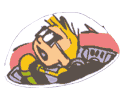 Spaceman Spiff
- Spaceman Spiff predates Calvin and Hobbes by over a decade.
Bill
trace Spiff back to a comic strip he drew for high school German class,
called Raumfahrer Rolf (Raumfahrer Rolf? What kind of name is
that?!). It was a pretty silly two-page comic in
which the protagonist got eaten by a monster at the end, but it was written
in some sort of German, (Oh.) and that was what counted. Bill reworked the character
in college, calling him "Spaceman Mort", (Gettin' Better) but the strip was conceived as a
fairly elaborate, continuing project and that didn't seem like the best use
of my academic time, so Watterson never published it.
Spaceman Spiff
- Spaceman Spiff predates Calvin and Hobbes by over a decade.
Bill
trace Spiff back to a comic strip he drew for high school German class,
called Raumfahrer Rolf (Raumfahrer Rolf? What kind of name is
that?!). It was a pretty silly two-page comic in
which the protagonist got eaten by a monster at the end, but it was written
in some sort of German, (Oh.) and that was what counted. Bill reworked the character
in college, calling him "Spaceman Mort", (Gettin' Better) but the strip was conceived as a
fairly elaborate, continuing project and that didn't seem like the best use
of my academic time, so Watterson never published it.
A year or so after college, the newly christened Spaceman Spiff
(Fyu.)
was Bill's first strip submission to newspaper syndicates. Spiff was a
diminutive loudmouth, not like Calvin, albeit with a Chaplin mustache,
flying goggles, and a cigar. He had a dimwitted assistant named Fragile, and
they roamed through space in a dirigible (Dirigible?). For obvious reasons, the
syndicates rejected it. Years later, when Bill came up with Calvin, Bill finally
had the opportunity to bring Spiff back.
When Bill was a kid, He followed the Apollo moon program with great interest,
so Calvin shares that fascination with space travel. Spaceman Spiff is also
a bit of a spoof on Flash Gordon. The narration in Flash Gordon
is fairly overwrought, so Bill have Spiff describe his own exploits with the
similar search for breathless superlatives.
The Spiff strips are limited in narrative potential, but Bill kept doing
them because they're so much fun to draw. The planets and monsters offer
great visual possibilities, especially in the Sunday strips. Most of the
alien landscapes come from the canyons and deserts of southern Utah, a place
more weird and spectacular than anything he'd previously been able to make
up. The landscapes have become a significant part of the Spaceman Spiff
sequences, and Bill often write the strip around the topography Bill feel like
drawing.
Like all of Calvin's fantasies, Spaceman Spiff provides a way for Bill to
draw some other comic strip when Bill want a break from Calvin and Hobbes.
Bill can draw and write things that wouldn't fit in the strip otherwise, and
this opens up opportunities to experiment with new interests.
After reading Watterson's explanation of Spiff's origin, and how he
sometimes gets bored of drawing the same old thing, I can see why he so
often used Spiff strips. But, I have to say, I am really a fan. Truth
be told I don't usually skip the Spiff strips in the books. I'm just amazed
how it's
never seems to be
the same thing over and over, and the comic books dialog doesn't bored me! Some of
my friends like the Spiff, and many webmasters of Calvin and Hobbes web
sites really like Spiff.
One thing I really do like about the Spiff strips is the art,
especially in color editions. Great art in comic
strips is pretty much non-existent, and that's why Spiff comics stand out so
much.
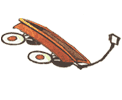 Wagon
- Calvin's wagon is a simple device to add some physical comedy to the
strip, and Bill most often use's it when Calvin gets longwinded or philosophical.
I think the action lends a silly counterpoint to the text, and it's a lot
more interesting to draw than talking heads. Sometimes the wagon ride even
acts as a visual metaphor for Calvin's topic of discussion.
Wagon
- Calvin's wagon is a simple device to add some physical comedy to the
strip, and Bill most often use's it when Calvin gets longwinded or philosophical.
I think the action lends a silly counterpoint to the text, and it's a lot
more interesting to draw than talking heads. Sometimes the wagon ride even
acts as a visual metaphor for Calvin's topic of discussion.
Calvin rides the wagon through the woods, bouncing off rocks and flying
over ravines. When Bill was a kid, his backyard dropped off into a big woods,
but it was brambly and swampy, not like Calvin's, which seems to be more
like a national forest. Bill was not a real outdoorsy kid, but occasionally
he'd
tramp out through the bush to map a pond, or try to see unusual birds and
animals. Calvin's woods is important to the strip, because it's the place
where Calvin and Hobbes can get away from everyone and be themselves. The
solitude of the woods brings out Calvin's small, but redeeming,
contemplative side.
Calvin has a contemplative side?!
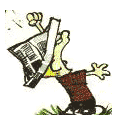 G.R.O.S.S. - The
Get Rid Of
Slimy girlS club is based on
similar clubs Bill's next-door neighbor and him formed when They were kids.
There mission? Harass neighborhood girls, but if they wouldn't come out,
they'd often settle for harassing Bill's brother. We prepared for a lot of
great struggles that never happened. Once they gathered big hickory nuts,
loaded them into a suitcase, locked it so nobody else could open it, and
stashed it up high in a tree. When the Critical Moment came, they planned to scramble up
the tree and unleash a hail of nuts upon our astonished pursuers. Six months
later, when the leaves were down, They looked up and discovered the suitcase
was still in the tree. The hinges had rusted, the nuts had rotted, and the
suitcase was ruined. There great plans often had this kind of boring
anticlimax, which is why fiction comes in so handy.
G.R.O.S.S. - The
Get Rid Of
Slimy girlS club is based on
similar clubs Bill's next-door neighbor and him formed when They were kids.
There mission? Harass neighborhood girls, but if they wouldn't come out,
they'd often settle for harassing Bill's brother. We prepared for a lot of
great struggles that never happened. Once they gathered big hickory nuts,
loaded them into a suitcase, locked it so nobody else could open it, and
stashed it up high in a tree. When the Critical Moment came, they planned to scramble up
the tree and unleash a hail of nuts upon our astonished pursuers. Six months
later, when the leaves were down, They looked up and discovered the suitcase
was still in the tree. The hinges had rusted, the nuts had rotted, and the
suitcase was ruined. There great plans often had this kind of boring
anticlimax, which is why fiction comes in so handy.
Is there any guy who wasn't in a club when he was young? Hobbes' and
Calvin's great plans always seem to backfire, which as Watterson mentions
is better than nothing ever happening with the well devised plans.
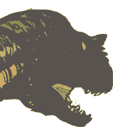 Dinosaurs
- The dinosaurs Bill put in Calvin and Hobbes have become one of my
favorite additions to the strip. Dinosaurs have appeared in many strips
before his, but I like to think he treated them with a little more
respect than they've often received at the hands of cartoonists.
Dinosaurs
- The dinosaurs Bill put in Calvin and Hobbes have become one of my
favorite additions to the strip. Dinosaurs have appeared in many strips
before his, but I like to think he treated them with a little more
respect than they've often received at the hands of cartoonists.
When Bill was Calvin's age, he had a nicely illustrated dinosaur book and
some dinosaurs models, so it was a natural step to have Calvin share that
interest. The first dinosaurs he put in the strip were based on his childhood
memories of them. Back in the 60's, dinosaurs were imagined as lumbering,
dim-witted, cold-blooded, oversized lizards. That's how he drew them in the
first strips, and these drawings are now pretty embarrassing to look at.
when he realized that dinosaurs offered Calvin interesting story
possibilities, Bill started searching for books to rekindle his interest in
them. It was then Bill discovered what he'd missed in paleontology during the
last twenty years.
Dinosaurs, Bill quickly learned, were wilder than anything he'd ever
imagined. Tails up, with birdlike agility, these were truly the creatures of
nightmares. Bill's drawings began to reflect the new information, and with each
new strip, he tried to learn more and to depict dinosaurs more accurately.
He did this partly for his own amusement, and partly because, for Calvin,
dinosaurs are very, very real. Dinosaurs have expanded Calvin's world and
opened up some exciting graphic possibilities. The biggest reward for him,
however, has been the fun he had exploring a new interest. Bill enjoyed
dinosaurs more now than he did as a kid, and much of the job of being a
cartoonist lies in keeping alive a sense of curiosity and wonder. Sometimes
the best way to generate new ideas is to go out and learn something.
I'm a fan of the Dinosaurs. Like Spaceman Spiff
strips, they don't seem to be the same thing over and over. A, again like
Spiff, the artwork is often beautiful.
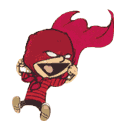 Stupendous
Man - Stupendous Man is one of my favorite alter ego. I think this is the
case because all of his actions take place in the real world, and are not
"confined" to Calvin's imagination. Few strips are funnier than Stupendous
Man strips, and they are consistently funny. I wish there were a few more
stories devoted to this imaginative alter ego, but maybe the well was dry.
It says something that there aren't any bad Stupendous Man strips.
Stupendous
Man - Stupendous Man is one of my favorite alter ego. I think this is the
case because all of his actions take place in the real world, and are not
"confined" to Calvin's imagination. Few strips are funnier than Stupendous
Man strips, and they are consistently funny. I wish there were a few more
stories devoted to this imaginative alter ego, but maybe the well was dry.
It says something that there aren't any bad Stupendous Man strips.
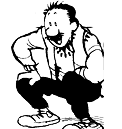 Uncle Max
- I really enjoyed the Uncle Max storyline, I was always wondering how
someone from "outside" Calvin's World would react to his shenanigans. I
wish that Watterson had brought this character back. Sigh.
Uncle Max
- I really enjoyed the Uncle Max storyline, I was always wondering how
someone from "outside" Calvin's World would react to his shenanigans. I
wish that Watterson had brought this character back. Sigh.
 Tracer Bullet - I love
Tracer Bullet. The art, with its dark, high contrast lighting, truly looks
like a 40's detective movie. I believe that Tracer Bullet is Watterson's
best looking work. Its a shame that there aren't more Bullet stories.
Amusingly, I doubt a comic strip artist today could get away with having a 6
year old smoking a cigarette and carrying a handgun... Society
is going downhill, if ,that is, you ask me. It's also a spoof of "Sam Spade ,Private
Eye".
Tracer Bullet - I love
Tracer Bullet. The art, with its dark, high contrast lighting, truly looks
like a 40's detective movie. I believe that Tracer Bullet is Watterson's
best looking work. Its a shame that there aren't more Bullet stories.
Amusingly, I doubt a comic strip artist today could get away with having a 6
year old smoking a cigarette and carrying a handgun... Society
is going downhill, if ,that is, you ask me. It's also a spoof of "Sam Spade ,Private
Eye".

